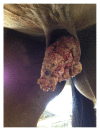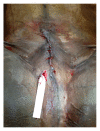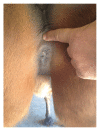Long-Term Outcome of En Bloc Extensive Resection of the Penis and Prepuce Associated with a Permanent Perineal Urethrostomy in a Gelding Affected by Squamous Cell Carcinoma
- PMID: 29955421
- PMCID: PMC6005296
- DOI: 10.1155/2016/6989450
Long-Term Outcome of En Bloc Extensive Resection of the Penis and Prepuce Associated with a Permanent Perineal Urethrostomy in a Gelding Affected by Squamous Cell Carcinoma
Abstract
A 15-year-old gelding was referred for a florid, cauliflower-like ulcerated mass, enclosing penis and prepuce together with penile urethra showing a malodorous purulent and blood-stained discharge and larvae infestation. En bloc extensive resection of the penis and prepuce, without penile retroversion or pexy to ventral abdomen associated with a permanent perineal urethrostomy, was performed. Histology of the mass revealed a squamous cell carcinoma of penis and prepuce. The surgical technique that was adopted is a modified version of that already described that allows a more proximal resection of the penile body and is a valid option for treating advanced SCC lesions involving the penis. Early postsurgical complications (mild strangury, haemorrhage from the urethrostomy site and its partial dehiscence, and infection of the abdominal wound) were managed with a medical treatment and resolved within 5 to 12 days. Three years after surgery the horse is in good body condition and does not show any sign of recurrence or disorders related to the surgery.
Conflict of interest statement
The authors declare that there are no competing interests regarding the publication of this paper.
Figures



References
-
- Junge R. E., Sundberg J. P., Lancaster W. D. Papillomas and squamous cell carcinomas of horses. Journal of the American Veterinary Medical Association. 1984;185(6):656–659. - PubMed
-
- Mair T. S., Walmsley J. P., Phillips T. J. Surgical treatment of 45 horses affected by squamous cell carcinoma of the penis and prepuce. Equine Veterinary Journal. 2000;32(5):406–410. - PubMed
-
- Joyce J. R. Cryosurgical treatment of tumors of horses and cattle. Journal of American Veterinary Medicine Association. 1976;168(3):226–229. - PubMed
Publication types
LinkOut - more resources
Full Text Sources
Other Literature Sources
Research Materials
